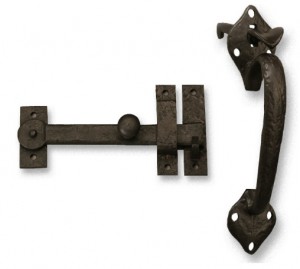Categories of Gate Latches | Securing Your Gate | Gate Latch Material |
Types of Gate Latches | Chart of Gate Latch Options | The Do’s and Don’ts of Gate Latches
Picking out gate hardware can be daunting. Not only do you need to figure out which material and style works for you, but you have to learn enough to know that certain pieces will work together and will install properly on your style of gate.
Consider getting a gate hardware package or a gate latch set so that everything coordinates well.
After many calls from customers who needed assistance putting together a selection of gate hardware that worked for their situation, we began building gate hardware sets and packages to help ease the decision-making. With gate latches we’ve created basic packages that include hinges (in the same finish) so that you have everything you need to hang your gate. Additional products like dummy hinge fronts, clavos, or security measures like a deadbolt can be added on, so that everything has the same finish and styling.
When you take into account all of the custom and one-off gate latches out there, there really are many choices in styling. However, there are 3-4 standard styles that comprise the majority of the market.
As we’ve mentioned on other pages, there are one sided and two-sided gate latches. A one-way gate latch means it is operable only on one side of the gate (usually the yard-side (inside) of the gate). Two-way gate latches allow the wooden gate to be opened from either side of the gate (the yard-side and the street-side).
- Thumb Latches
- Ring Latches
- Lever Latches
- Bolt Latches
Thumb Latches
Thumb latches are two-way latches and work as follows: on the outside (street-side) of the gate is a decorative plate with a thumb depressor. When you depress the thumb, a latch-arm on the inside of the gate lifts and allows the gate to be opened. Closing the gate, the latch-arm should hit the strike, rise up and fall into the catch on its own (a gravity latch).
Thumb latches can be installed only on in-swinging gates and are always double-sided. Some thumb latches are lockable, some are not.
See 360 Yardware’s selection of thumb latches.


Ring Latches
A ring latch is a two-sided gate latch, operable from both sides of the gate. On the street-side of the gate, you’ll have a backplate with a ring on it. The yard-side will have a backplate also with a ring on it, but the ring will be attached to a latch-arm. Turning the ring from either side lifts the arm out of the catch so the gate can open.
Ring latches can be either gravity-assisted or spring-loaded, depending on the manufacturer.
Ring latches can be installed on both in-swinging and out-swinging gates. On out-swinging gates, however, the latch-arm side of the gate latch will be on the street-side of the gate. The best way to remember is that the latch-arm of the gate latch must be installed on the side that the gate opens toward.
Some ring latches are lockable, some are not.
See 360 Yardware’s selection of ring latches.

Lever Latches
Lever latches operate in the same way as a ring latch, but instead of a ring on each side, there’s a lever handle.
Lever latches can be installed on both in-swinging and out-swinging gates. On out-swinging gates, the latch-arm side will be on the street-side of the gate. The best way to remember is that the latch-arm of the gate latch must be installed on the side that the gate opens toward.
Lever latches can be either gravity-assisted or spring-loaded, depending on the manufacturer. Some lever latches are lockable; some are not.
See 360 Yardware’s selection of lever latches.


Bolt Latches
Some bolt latches might remind you of the old days, when you tied a string to a latch, tossed it over the gate, and called it good. Now there are a few spiffier versions of the old stand-by. We offer a nice selection of architectural bolt latches
Usually bolt latches can be installed on either side of a gate. They are one way gate latches, operable only from the one side (although a string can get you access from the other side from the old style latch). Bolt latches are sometimes lockable, sometimes not. The lockable ones usually require an additional padlock.
See 360 Yardware’s selection of bolt style latches.

